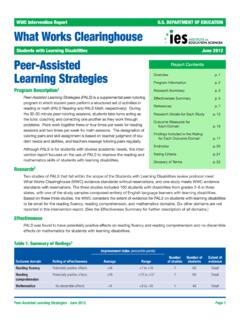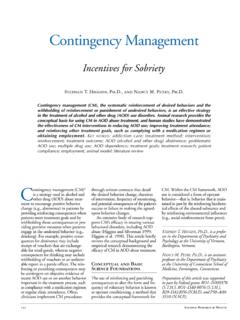Transcription of Qualitative Research Design - SAGE Publications Inc
1 4 QualitativeResearch DesignAcommon feature of Qualitative projects is that they aim to createunderstanding from data as the analysis proceeds. This meansthat the Research Design of a Qualitative study differs from that ofa study that starts with an understanding to be tested, where often thehypothesis literally dictates the form, quantity, and scope of requireddata. This sort of Design preempts other ways of looking at the Research is usually not preemptive. Whatever the studyand whatever the method, the indications of form, quantity, and scopemust be obtained from the question, from the chosen method, from theselected topic and goals, and also, in an ongoing process, from the Research Design is both challenging and essential, yet it is the leastdiscussed and least adequately critiqued component of many from a preemptive Research Design should never be seen asrelease from a requirement to have a Research Design .
2 In Chapter 2, weestablished how a Research purpose points to a Research question and howthe question informs the choice of method. But these choices do notremove the task of designing a Qualitative project. Therefore we start thischapter by looking first at the levels of Design and then at the goals ofdesigning to specify the ultimate scopeof a project and the typeof datarequired. We end with practical advice on how you can tackle the ongo-ing tasks of designing your project so that you develop a Research topicinto a researchable question; we discuss the different levels and ways ofplanning, and the pacing of the project as a 10/11/2006 9:46 PM Page 73 THE LEVELS OF DESIGNR esearch Design is created by the researcher, is molded (rather thandictated) by the method, and is responsive to the context and the partic-ipants.
3 Creating Research Design involves seeing the project at differentlevels. Once you have located your project methodologically, you need todesign the pacingof processes and strategiesto be used, and at the sametime you need to see the project as a pacingof the project involves planning the sequencing of itscomponents and the movement between data gathering and data analy-sis. This requires ongoing decisions during the project: When shouldyou stop interviewing? When do you return to observing as processesof analysis show that more data are needed to verify, or when thin areasin analysis are revealed? The selection of method informs selectionof Research strategies, but these are also chosen in the context ofthe Research question ( , what you want to find out) and the researchcontext. For example, in studying the experience of menopause in aNewfoundland village, Davis (1983) relied on interviews rather thanobservational data.
4 Richards, Seibold, and Davis (1997) were investigat-ing the social construction of menopause, so they used observation ofwomen s support groups and information centers as well as many formsof overall Design of the project must be aimed at answering yourresearch question, and we look at detailed examples of Design below. Youneed to Design a project that both fits and is obtained from the question,the chosen method, the selected topic, and the Research goals. You shouldtreat Research Design as a problem to be considered carefully at the begin-ning of the study and reconsidered throughout it is never a DESIGNW here to start? If the questions, problem, and method are to guidedesign, then this becomes a highly conceptual and complex process. It ishelpful to start with two questions: What is the scopeof this project?
5 AndWhat is the natureof the data required?74 THINKING 10/11/2006 9:46 PM Page 74 The Scope of the ProjectBy scope,we refer to the domain of inquiry, the coverage and reach ofthe project. Scope involves both the substantive area of inquiry (the lim-its of the Research topic) and the areas to be researched (the setting[s] andthe sample).Definitions of the topic and the relevant concepts and theories asperceived by other investigators in part delimit the area of of the scope of the study continues in the process of gath-ering and analyzing data. You must work carefully and in depth, withoutlosing sight of the Research goals; remain flexible, self-critical, and, at alltimes, analytic; and use the literature as a comparative template. Codingdecisions demand that you constantly ask: Is this an instance of this cat-egory, or is it something different?
6 During the project, you must contin-ually revisit the substantive scope of inquiry. If the data do not fit thequestion, analysis is likely to lack clear focus; the project may take toolong to saturate and conceptualize and so, frustratingly, may achieve verylittle. On the other hand, if the scope is set too rigidly too early, the studywill be severely limited. Avoid preemptively committing your study todefinitions of the phenomenon of interest and concepts from the litera-ture, thereby predetermining meanings of concepts; avoid making deci-sions too early in the study and drawing conclusions too quickly. Suchpreemptive scoping will result in premature scope of the sampleand the selection of the setting are driven bytwo principles. One is that setting and sample are purposively may involve choosing the best, most optimal example of the phe-nomenon and the setting in which you are most likely to see whatever itis you are interested in.
7 It may involve observing or interviewing expertsin that particular topic or experience. Alternatively, you may select a set-ting because it allows you to obtain examples of each of several stancesor experiences. The study may proceed by snowball sampling (seekingfurther participants by using the recommendations of those participantsalready in the study).The second principle of sampling is that once you have begun to under-stand whatever it is you are studying, your sampling strategies normallyare extended through theoretical sampling(Glaser, 1978). This means thatyour selection of participants is directed by the emerging analysis, andthe theory being developed from data is subsequently modified by dataQualitative Research Design 10/11/2006 9:46 PM Page 75obtained from the next participants. The scope of a study is never just aquestion of how many, but always includes who, where, and which set-tings will be studied; in what ways, by whom, and for how long they willbe studied; and what can be asked and answered.
8 All of these questionsmust be asked repeatedly as the project progresses. The Research questionmay require that you seek out negative cases(examples of experiences thatare contrary to cases that support the emerging theory, and that providenew dimensions, perhaps as indicated by the theory but not yet encoun-tered) or thin areasfrom participants who have experienced special condi-tions that have been identified as significant. The scope of a project isbigger than its sample, for participants provide information about otherslike themor unlike shadowed data (Morse, 2001) provideyou with further direction for your theoretical sampling. When sampling,you must be aware of when you are working inductively and discoveringand when you are working deductively and interrelationship of the two components of scope becomes clearduring the processes of data gathering and analysis.
9 You need to ask con-stantly, What scale of data and what range of settings and sources of datawill give the strands required for thisquestion, thistopic, thismethod,thisaudience, thisdisciplinary or political context? Asking and answer-ing these questions about the project will help you to locate it, to estab-lish the bounds of the question to be addressed and the goals to berethought and realistically the ScopeScopingis an ongoing process in a project. It is rare for a qualitativeresearcher to set a scope and stick to it. Adjustments to the mode of mak-ing data are frequently required so that the project can be data driven. Butthis does not mean that such changes can just happen. Changes ideallybuild upon the researcher s growing understanding of the recommend that you always keep in mind the following issuesregarding scoping:The substantive scopeof a project involves issues of comparison( Will I understand the wider situation if I stay in this group?)
10 And inter - vention ( Before I influence policy, how would I know if I were wrong? ).How many perspectives are needed? It is hard, for example, to studyrelationships only by observing interaction. If your question is about the76 THINKING 10/11/2006 9:46 PM Page 76relations between management and staff, you need to observe, if possible,but you must interpret your observations strictly in terms of yourpresence. You will also need other data sources; you need to talk to themanagers and the staff, and you should examine relevant data sources will provide conflicting information and you as theresearcher have to make sense of the for changeinvolves asking if this is a study of a process(most Qualitative studies are) and, if so, what time period it of studying a process with static data. One-off interviews, forexample, will give interviewees accounts, or the versions they see asappropriate in the interview situation, of what happened in the past.
















